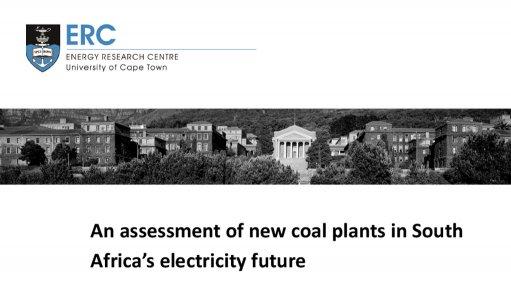
A report released by the University of Cape Town’s Energy Research Centre (ERC) shows that government’s planned independent power producer (IPP) coal plants – Thabametsi and Khanyisa – would cost South Africa an additional R19.68-billion compared to a least-cost energy system.
Thabametsi (557 MW to be based near Lephalale, Limpopo) and Khanyisa (306 MW to be based near eMalahleni, Mpumalanga) are the preferred bidders under the first bid window of the coal-baseload IPP procurement programme.
The new report shows that the two coal IPPs are not needed to meet South Africa’s medium-term electricity demand. Where future capacity is needed, this is met more cheaply by other electricity sources such as wind, solar, and flexible gas generation.
“These new coal IPPs are excessively expensive and polluting, and crowd out other cheaper, cleaner, and more flexible alternatives. They would increase costs in the electricity sector unnecessarily, in circumstances where we already have a large surplus of generation capacity,” says Gregory Ireland of the ERC.
The new plants would also increase greenhouse gas (GHG) emissions by 205,7Mt CO2eq over the 30 year period of the power purchase agreements, and negate most of government’s emission mitigation plans, including the vast majority of the expected savings of the entire Energy Efficiency Strategy to 2050. They would further impact South Africa’s commitments under the Paris Agreement, raising the costs of mitigation dramatically and requiring significant GHG emission cuts elsewhere in the electricity sector and in other sectors. If the coal IPPs were to operate at the capacities authorised by their environmental authorisations (Thabametsi 1200MW, and Khanyisa 600MW), the costs and impacts would increase proportionally, and would be roughly doubled.
Robyn Hugo, head of the Centre for Environmental Rights’ Pollution and Climate Change programme, says: “A least-cost IRP does not require new coal-fired power stations to be built, so the coal IPPs make no sense. Spending an additional R20-billion on two new coal IPPs would not be in the public interest.”
Bobby Peek, director of environmental justice organisation groundWork, says: “Eskom is facing a financial crisis and rising electricity prices will drive consumers away from the utility. But the enormous additional expense of the coal IPPs would impact most directly on the poor, who are already hardest hit by the devastating health and other impacts of polluting coal-fired power generation.”
The coal plants are required to commence operating by December 2021, but numerous required licences and authorisations are outstanding and/or are currently being challenged in the High Court by the Life After Coal Campaign. Neither project has reached financial close yet.